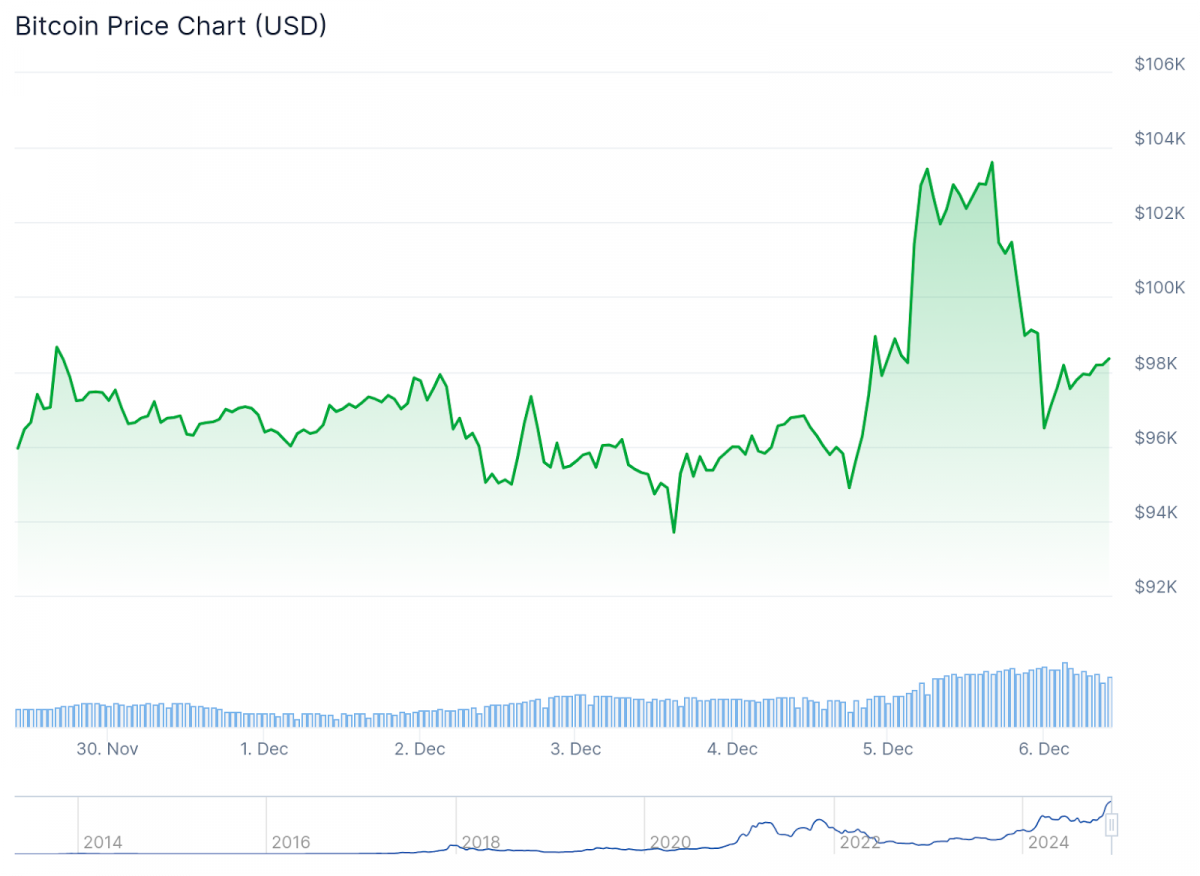Bitcoin Reaches $100K, But Cathie Wood Believes Its True Potential Is Just Beginning To Unfold


In Brief
Cathie Wood views Bitcoin’s recent high of $100,000 as a significant milestone in the growing acceptance and importance of crypto, highlighting its revolutionary potential.

Bitcoin’s price has surpassed $100,000, marking a new high. Cathie Wood, CEO of ARK Invest, views this accomplishment as a chapter in a larger, developing narrative of crypto acceptance and importance rather than as a destination. Her viewpoint draws attention to Bitcoin’s revolutionary potential and emphasizes that the digital asset’s present value just touches the surface of what it is capable of.
The $100K Bitcoin Milestone: A Historic Event
The $100,000 milestone marks a turning point in the history of Bitcoin and demonstrates the progress made since its initial transaction in 2009. Market sentiment has combined with institutional acceptance and regulatory hope to carry Bitcoin to new heights. Wood asserts that structural elements supporting Bitcoin’s growth go beyond speculative interest.
Cathie Wood’s comments highlight her company’s long-held belief that Bitcoin is a game-changing financial asset. She contends that the key characteristics of the digital currency—scarcity, decentralization, and worldwide accessibility—distinguish it from more conventional assets like gold.

Photo: CoinGecko
Is Bitcoin a Digital Successor to Gold?
A foundation for comprehending Bitcoin’s potential is provided by Federal Reserve Chair Jerome Powell’s remark that it is a “digital version of gold.” With a market valuation of almost $15 trillion, gold has been a store of value for ages. Despite its quick rise, Bitcoin is currently valued at almost $2 trillion. According to Wood, Bitcoin is a more wider notion than gold since it is digital, decentralized, and transnational.
In contrast to gold, which has a relatively elastic supply influenced by mining advancements, Bitcoin has a limited quantity of 21 million coins. It adds aspects that gold cannot match because of its programmability and incorporation into a digitally first society. Due to these factors, Wood thinks that Bitcoin’s development is far from over and has the potential to continue challenging conventional ideas about value storage.
Regulatory Changes and Institutional Support
The shifting regulatory landscape has contributed to the recent price spike. Market excitement increased when it was announced that pro-crypto Paul Atkins would be the next head of the SEC under President-elect Donald Trump. The selection of Atkins marks a major shift from the leaving chair Gary Gensler’s crypto-skeptic viewpoint since Gensler led a record number of enforcement proceedings against crypto companies.
It is anticipated that this change in legislation would create an atmosphere that is more favorable to innovation in the crypto sector. An example of how regulatory certainty might encourage institutional engagement is the adoption of spot Bitcoin ETFs earlier in 2024. Significant money inflows have already been drawn to companies like BlackRock and Fidelity, highlighting the increasing acceptability of Bitcoin by the general public.
The Quick Development of Bitcoin: A Comparison with Tech Giants
Bitcoin’s quick adoption curve is demonstrated by the fact that it reached a $2 trillion market valuation in less than 16 years. For comparison, Apple took 42 years to reach this milestone, whereas Amazon did it in 29 years. This acceleration demonstrates how blockchain technology has the potential to upend traditional banking structures.
The market domination of cryptocurrencies, which make up more than half of the ecosystem of digital assets, solidifies their place as major players. The expanding number of institutional goods linked to Bitcoin further solidifies this growing credibility.
Bitcoin’s volatility still raises doubts about its stability as an investment, despite the excitement. Dramatic price fluctuations have characterized the cryptocurrency’s history; previous bull runs were frequently followed by abrupt corrections. Analysts warn that this volatility, which is fueled by macroeconomic variables and speculative trading, continues to be a distinguishing characteristic.
According to investment expert Dan Coatsworth, Bitcoin is a high-risk asset that is inappropriate for cautious investors. Although many have benefited from its explosive growth, caution is necessary due to the volatility of Bitcoin’s price fluctuations.
The Function of Retail Investors and the Fear of Missing Out
The fluctuations in Bitcoin’s price have been influenced by retail investors’ fear of missing out (FOMO). Younger investors are becoming more interested in the cryptocurrency market as it continues to set records because they want to be exposed to its high profits. But there are hazards associated with this excitement.
While the popularity of Bitcoin may encourage interest in other cryptocurrencies, many speculative investments in meme coins have failed, according to Carol Alexander, a professor of finance at Sussex University. This emphasizes how important it is to make well-informed decisions in a field where hype and false information are common.
The Wider Implications of Bitcoin’s Growth
The rise of Bitcoin to $100,000 is indicative of more changes in the financial system. It is becoming more widely accepted, as seen by institutional investors’ increasing acceptance of it. Cryptocurrency is becoming an essential component of the global economy, as seen by its incorporation into conventional financial institutions through ETFs, payment platforms, and company balance sheets.
Furthermore, in a world where digital networks are connecting people more and more, Bitcoin’s global reach offers special benefits. Its applicability in both established and emerging nations is highlighted by its capacity to act as a financial inclusion tool and an inflation hedge.
There are still unknowns even though the regulatory environment seems more favorable under the new government. The future of the cryptocurrency business will be greatly influenced by its interactions with authorities. To encourage innovation while shielding investors from fraud and market manipulation, clear and uniform regulations are crucial.
Paul Atkins and other pro-crypto officials’ appointments signal to a change in direction toward a more balanced regulatory strategy. To establish long-term trust, the sector must carefully negotiate this changing environment while maintaining compliance and openness.
Disclaimer
In line with the Trust Project guidelines, please note that the information provided on this page is not intended to be and should not be interpreted as legal, tax, investment, financial, or any other form of advice. It is important to only invest what you can afford to lose and to seek independent financial advice if you have any doubts. For further information, we suggest referring to the terms and conditions as well as the help and support pages provided by the issuer or advertiser. MetaversePost is committed to accurate, unbiased reporting, but market conditions are subject to change without notice.
About The Author
Victoria is a writer on a variety of technology topics including Web3.0, AI and cryptocurrencies. Her extensive experience allows her to write insightful articles for the wider audience.
More articles

Victoria is a writer on a variety of technology topics including Web3.0, AI and cryptocurrencies. Her extensive experience allows her to write insightful articles for the wider audience.

















































